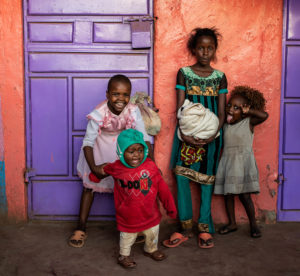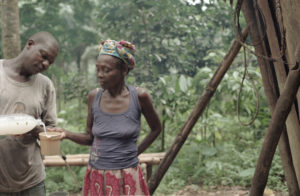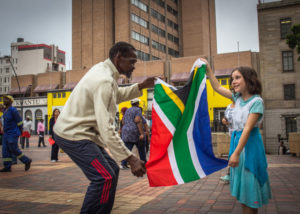Im Herbst 2018 hat der Fachverband Afrikanistik e.V. zu einem Fotowettbewerb aufgerufen. Das Thema des Fotowettbewerbs sollte eine mit dem Fach Afrikanistik verbundene Erfahrung, einen typischen Aspekt des Beruffeldes darstellen. Die Wahl des Themas fiel sehr rasch auf die „Feldforschung“. Die Teilnehmer waren dazu aufgerufen, Bilder einzusenden, die ihre Erfahrungen, Erlebnisse, Begegnungen, festhalten, die sie mit ihren Feldforschungsreisen verbinden.
Feldforschung gehört zum Kern afrikanistischer Tätigkeit, sie ist sozusagen das Herzstück der meisten empirisch arbeitenden Kollegen. Die systematischen Beobachtungen, die auf Feldforschung gemacht und zusammengetragen werden, sind die Grundlage, auf denen die Analysen und Schlussfolgerungen des Forschers beruhen. Doch die Feldforschung liefert nicht nur Daten, sie eröffnet dem Forscher auch Lebenswelten und -realitäten, die er sensibel wahrnehmen und – zumindest in Teilen – mit(er)leben kann.
Der Gewinner des Fotowettbewerbs ist Moritz Heitzer von der Hochschule Neu-Ulm, der im November 2018 ein junges Solarsystem-Unternehmen in Kenia begleitet hat. Die Aufnahme entstand auf einem kleinen Markt in der Region Mwea. Moritz Heitzer berichtet:
In der Straße fand eine spontane Produktpräsentation der Systeme statt. Auf diesem Bild sind Kinder aus der Nachbarschaft zu sehen. Geschwister und Freunde spielen zur Abendstunde auf der Straße.

Kolonialgeschichte aus der Perspektive derjenigen, die für ihre Unabhängigkeit gegen die Kolonialmacht und Weißen Siedler gekämpft haben, dokumentiert die Trägerin des zweiten Preises Anais Angelo von der Universität Wien mit ihrem Bild „Recovering memories“.

Frau Angelo hat das Bild in Muthara (Meru), Kenia, aufgenommen und schreibt dazu Folgendes:
In 1963, Kenya became a sovereign state. Yet not all of those who had fought for independence, were satisfied with the result. Meru, a small, rural district, continued to be a hotspot of resilience by fighters who called themselves the Mau Mau. One leader in particular, Field Marshal Mwariama, claimed he would continue the fight until the new government agreed to a more equitable redistribution of land. Two years later, Mwariama was killed by the police and his death marked the end of resistance. So much was clear from the archives, yet details were missing from the official reports. So in 2015, I travelled to Meru to find out what exactly had happened forty years earlier.
The women and men you see on the picture were Mau Mau fighters, who had all known Mwariama and agreed to revisit and share their memories. At the end of the interviews, which took place at the Heritage Center of the Mau Mau War Association in Muthara, Meru, they blessed me and my research with songs, hoping that their history would be written and heard.
Der Träger des dritten Preises Luís Cronopio von der Universität zu Köln weist auf die Problematik der Feldforschung hin, insbesondere auf die Gefahr, dass das zu erforschende Feld allzu oft zum Projektionsfeld eigener Charakterschwächen und Sehnsüchte transformiert.

Er weist zu seinem Bild „bulala“ auf Folgendes hin:
Whenever we encounter a stranger we can always see a little bit more of ourselves. What once was a moment of excitement, turns, in a fraction of a second, into a dream. Photography is an excuse to come closer but also to walk away; it is the attempt to represent life and time and death and emotion, through an object. And yet, it seems that every photograph is only the myth the photographer created. When we endeavor in the game of fieldwork, we solemnly believe that the end and the means are mutually inclusive, but that can never happen: time does not stop and meaning is an artifact of disguise.
Fieldwork is a ritual. The anthropologist is a tourist with a method, a working visa and a prediction. But what is the researcher, re-searching? As if she had searched it before, and had not found it. And what was he looking for in the first place?
Der Gewinner des Sonderpreises ist Michael Steffen von der Universität Bayreuth, der das Bild „breaking the rainbow, buildung a nation“ in Port Elisabeth, Südafrika aufgenommen hat.

Zu seinem Bild schreibt Michael Steffen folgendes:
The transition from apartheid to a democratic order was probably one of the greatest achievements of the twentieth century. Between 1989 and 1994, negotiations of the two opponents, the African National Congress and the National Party, ended colonial and apartheid rule, and de facto – at least by law – colonial oppression. These events led to euphoria throughout the country. The people celebrated and embraced the concept of the rainbow nation. This transition brought undoubtedly enormous change to the lives of many South Africans. Given the fact that all South Africans enjoy full citizenship, human rights and protection under the Constitution of the Republic of South Africa. Nevertheless, the control of the economy continues to be in white hands, while poverty is black, the struggle for liberation and emancipation from mental slavery still continues.
Today, young people across the country are beginning to look through and beyond the mirage of 1994 – aiming for intergenerational discourse, constructing new identities, breaking the rainbow and building a nation in order to challenge and change the status quo.
Der Fachverband Afrikanistik e.V. gratuliert den Gewinner*innen des Fotowettbewerbs und bedankt sich bei allen Teilnehmer*innen für die Einsendung der „Feldforschungs“-Fotos!






